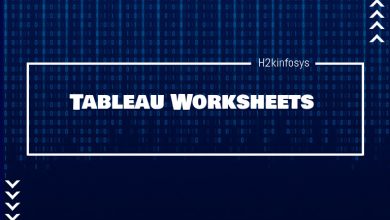Tableau Actions

You can add context and interactivity to your data using actions. For instance, in a dashboard showing home sales by neighborhood, you could use actions to display relevant information for a selected neighborhood. Selecting any neighborhood in one view can trigger an action that highlights the related houses in the map view, filters a list of the houses sold, and then opens an external web page showing census data for the neighborhood.
The different types of actions are:
- Filter: It uses the data from one view to filter data in another to help guide analysis.
- Highlight: Call attention to marks of interest by coloring specific marks and dimming all others.
- Go to URL: Create hyperlinks to external resources, such as a web page, file, or another Tableau worksheet.
- Go to Sheet: Simplify navigation to other worksheets, dashboards, or stories.
- Change Parameter: Let users change parameter values by directly interacting with marks.
- Change the Set Values: Let users change the values in a set by directly interacting with marks.
Filter Actions:
Filter actions are used to send information between worksheets. Usually, a filter Tableau actions sends information from a selected mark to another sheet showing the related information.
Create or edit a filter action:
Step 1: Do either of the following:
- On the worksheet, select Worksheet > Actions.
- On the dashboard, select Dashboard > Actions.
From the drop-down menu of the dashboard sheet, you can also select Use as Filter. In the dialog box Actions, generated appears in the default names of actions created this way.
Step 2: In the dialog box Actions, click Add Action, and then select the option Filter. Or, you can select an existing Tableau actions and choose Edit.
Step 3: Specify a name for the action.
Step 4: Select the source sheet or data source. If you select the data source or dashboard, you can select related sheets you want to launch the action.
Step 5: Specify how the action runs:
- Hover – It runs when you mouse over marks in the view.
- Select – It runs when you click marks in the view. To avoid running the Tableau actions while multiple marks are selected, select Run on a single select only.
- Menu – It runs when you right-click a mark in the view, and then click an option in the tooltip menu.
Step 6: Select a target sheet. When you select the dashboard, you can select one or more sheets within it.
Step 7: Specify what happens when the selection is cleared in the view:
- Leave the filter – It continues to show filtered results on the target sheets.
- Show all values – It changes the filter to include all values.
- Exclude all values – It changes the filter to exclude all values. This option is useful while building dashboards that only show some sheets if a value in another sheet is selected.
Step 8: Specify the data you want to show on the target sheets. You can also filter on All Fields or Selected Fields.
If you chose the option Selected Fields, do either of the following:
- In Tableau Online/Tableau Server, click a drop-down menu in the Source Field column, and select a field. Then you can select a target data source and field.
- In Tableau Desktop, click Add Filter.
Step 9: In the dialog box Add Filter, select source, and target data sources and fields.
When you run an Tableau actions from a specific mark on the source sheet, a filter is added to the target sheet that will only include values for the target field that match the source field. In the example of the comparable house, if the Source Field and Target Field are both set to Beds, then when you click a sheet link for a house with three bedrooms, the target worksheet shows only three-bedroom houses.
Highlight Actions:
Highlight actions allows you to call attention to marks of interest by coloring specific marks and dimming all others. You can also highlight marks in the view using a variety of tools. For instance, you can manually select the marks you want to highlight, use the highlighter to search for marks in context, use the legend to select related marks, or create an advanced highlight action.
Create a highlight action:
Step 1: On a worksheet, select Worksheet > Actions. From a dashboard, select Dashboard > Actions.
Step 2: In the Actions dialog box, click the Add Action button and then select Highlight.
Step 3: Name the action to identify in the Actions dialog box. Make the name descriptive like Highlight Products Shipped by Delivery Truck. You can also select variables from a drop-down list and use them in the name.
You can also use the drop-down for selecting the source sheet or data source. If you have selected a data source or a dashboard sheet, you can further select individual sheets within them.
Step 4: Select how you want to trigger the action. You can select any of the following options:
- Hover – It rests the pointer over a mark in the view to run the action. It works well for highlight and filter Tableau actions within a dashboard.
- Select – It clicks a mark in the view to run the action. It works well for all types of actions.
- Menu – Right-click on a selected mark in the view and then select an option on the context menu. It works well for filter and URL actions.
Step 5: Select a target sheet. If you select the dashboard, you can further select individual sheets within the dashboard.
Step 6: Select the fields that you want to use for highlighting. Select any of the following options:
- Selected Fields – It marks in the target sheet that is highlighted based on select fields. For instance, highlighting using the Ship Mode field will result in an action that will highlight all marks in the target sheet having the same ship mode as the selected mark in the source sheet.
- Dates and Times – It marks in the target sheet that is highlighted when the date and time match those of the marks selected in the source sheet. The source and target worksheets can have only one date field each; however, the date fields should have different names.
- All Fields – It marks in the target sheet that is highlighted when they match the marks selected in the source sheet.
Step 7: When finished, click on OK twice to close the dialog boxes and return to the view.
URL Actions:
A URL action is a hyperlink, which points to a web page, file, or other web-based resources outside Tableau Actions You can also use URL actions to create an email or link to additional information about your data. For customizing links based on your data, you can automatically enter field values as parameters in URLs.
How to open a web page with a URL action?
Step 1: On a worksheet, select Worksheet > Actions. From a dashboard, select Dashboard > Actions.
Step 2: In the Actions dialog box, click Add Action and then select Go to URL.
Step 3: In the next box, enter a name for the action. For entering field variables in the name, click the arrow to the right of the Name box.
You can use the drop-down to select a source sheet or data source. If you have selected a data source or dashboard, you can select individual sheets within it.
Step 4: Select how users will run the action.
Step 5: Specify a URL with an FTP, HTTP, or https prefix.
For entering field and filter values as parameters in the URL, click on the arrow to the right of the URL box.
Step 6: (Optional) Select any one of the following options:
- URL Encode Data Values – You can select this option if your data contains values that use characters that browsers do not allow in URLs. For instance, if one of your data values contains an ampersand like Sales & Finance, the ampersand must be translated into characters that your browser acknowledges.
- Allow Multiple Values – You can select this option if you are linking a web page that can receive lists of values through parameters in the URL. For instance, say you have selected several products in a view, and you want to see each product’s details that are hosted on a webpage. If the server loads multiple product details based on a list of identifiers, you can use the multi-select option to send the list of identifiers as parameters.
While allowing multiple values, you must also define the item delimiter, which is the character that separates each item in the list. You can also define the Delimiter Escape, which is used when the delimiter character is used in a data value.
Step 7: For URL Target, specify where the link will open:
- New Browser Tab – It opens in the default browser.
- Web Page Object – It opens in the web page object you select.
- Browser Tab When No Web Page Object Exists – It ensures that the URL opens in a browser on sheets that lacks web page objects. This option is best when Source Sheets is set to All or a data source.
Create an email with a URL action:
Step 1: Select Worksheet > Actions.
Step 2: In the Actions dialog box, click the Add Action button and select Go to URL.
Step 3: In the Source Sheets drop-down, select the sheet that contains the field with the email addresses you want to send.
In the URL textbox, type ‘mailto:’, click on the arrow button to select the field in your data that contains the email addresses. Type ?subject= and enter the text for the Subject line if you want.
Step 4: Type &body=, and click the arrow button to select the fields of information you want to include in the email body.
Parameter Actions:
You can use parameter actions to allow your audience to change a parameter value through direct interaction with a data visualization like clicking or selecting a mark. You can also use parameter actions with reference lines, calculations, filters, and SQL queries and customize how you display data in your visualizations.
Parameter actions open new possibilities for creating summary values and statistics without using calculations. You can also configure parameter actions to let users select multiple marks automatically aggregated into a single parameter value.
Create a parameter action:
Step 1: In a worksheet, select Worksheet >Actions. In a dashboard, select Dashboard >Actions.
Step 2: In the Actions dialog box, click Add Action and then select Change Parameter.
Step 3: In the dialog box Actions, specify a meaningful name for the Tableau actions.
Select a source sheet or data source. The current sheet gets selected by default. If you select the data source or dashboard, you can select individual sheets within it.
Step 4: Select how users will run the action.
- Hover – It runs when a user hovers the mouse cursor over a mark in the view. It also exposes an option for the action in the mark’s tooltip.
- Select – It runs when a user clicks a mark or selects multiple marks in the view.
- Menu – It runs when a user right-clicks a selected mark in the view, then selects an option on the context menu.
Under the Target option, specify the target parameter and a source field. All parameters available in the workbook are available in this Parameter list.
To let your users select multiple marks aggregated into a single parameter value, select an aggregation type.
The aggregation that you have chosen for the parameter action can be different than the aggregation used for that field in the view.
Step 5: Specify what will happen when the selection is cleared.
- Keep current value – The value of the current parameter will remain in the view.
- Set value to – Value of parameter will revert to the indicated value.
Step 6: Click on OK to save your changes and return to the view.
Set Actions:
You can use set actions to allow your audience to interact directly with visualization or dashboard to control their analysis aspects. When anyone selects marks in the view, set actions will change the values in a set.
Create a set action:
Step 1: In a worksheet, select Worksheet >Actions. In a dashboard, select Dashboard >Actions.
Step 2: In the Actions dialog box, click Add Action and then select Change Set Values.
Step 3: In the dialog box Add/Edit Set Action, specify a meaningful name for the action.
Select a source sheet or data source. The current sheet gets selected by default. If you select the data source or dashboard, you can select individual sheets within it.
Step 4: Select how users will run the action.
- Hover – It runs when a user hovers the mouse cursor over a mark in the view.
- Select – It runs when a user clicks a mark in the view. It works well for set actions.
- Menu – It runs when a user right-clicks a selected mark in the view, then selects an option on the context menu.
Step 5: Specify the target set by selecting the data source and then selecting the set.
Step 6: Specify what happens when the action is run in the view:
- Assign values to set – It replaces all values in the set with the values selected.
- Add values to set – It adds individually selected values to the set.
- Remove values from the set – It removes individually selected values from the set.
Step 7: Specify what happens when the selection is cleared in the view:
- Keep set values – Current values of the set remain in the set.
- Add all values to set – It adds all possible values to the set.
- Remove all values from the set – It removes previously selected values from the set.
Step 8: Click OK to save your changes and return to the view.





